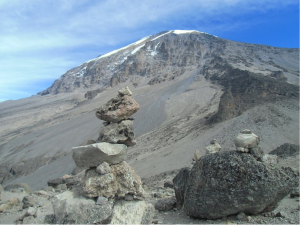Is it Safe to Climb Mount Kilimanjaro?

Climbing Mount Kilimanjaro is not without risks. Every year, about ten climbers fall to their deaths, and the number is estimated to be much higher, while another 1000 are evacuated to safety from the traps of the mountain. The primary cause of deaths is Altitude Mountain Sickness, AMS and everyone attempting a climb is seriously warned to monitor AMS symptoms.
Any aspiring climber needs to understand in advance the risks he’s anticipating and getting warned is a good idea and not a scare tactic. While dangers associated with high altitude climbing can’t be eliminated, they can be lessened when you follow the advice given by a professional climber.
What is acute mountain sickness
At sea level, the percentage of oxygen is about 21 per cent. As you climb higher, the percentage remains the same but the amount of oxygen is reduced with each breath you inhale. When you reach 12,000 feet (3,600 meters), there are only 40 percent oxygen molecules available in every breath you inhale, forcing your body to fight to adjust to the available oxygen at that level. As you continue hiking, your body is fighting a losing battle as it fails to adapt quickly enough to the reduced oxygen. This is called Acute Mountain Sickness, and it can attack the healthiest individual.
Acclimitisation
The primary cause of AMS is climbing too high too fast. Given enough time, your body can adapt to low levels of oxygen at a specific altitude. This is referred to as acclimatization and is a must for any aspiring climber. For successful acclimatization to take place, set aside two to three days at a given altitude. While acclimatization is taking place your body changes to enable it to cope with low levels of oxygen. Here is what takes place:
a. The depth of your respiration goes up
b. Your body produces more red blood cells to carry more oxygen
c. The pressure in your capillaries is increased. This forces blood to penetrate areas in your lungs which are generally not used when breathing normally.
d. The body releases more enzymes that cause oxygen to be absorbed by body tissues.
We may not exhaust the science involved, but the symptoms of AMS start at around 12 to 24 hours after arriving at altitude. These symptoms are:
o A headache
o Dizziness and nausea
o Lack of appetite
o Fatigue
o Shortness breathing
o Bad sleep
o General irritation
Other dangers while climbing
Apart from Acute mountain sickness, other dangers climbers are warned against while climbing Kilimanjaro are:
• Hypothermia (loss of heat due to cold)
• Slipping and falling off rocks
• Getting hit by avalanches
• Falling off cliffs
• Heart attacks
• Diarrhoea
• Cold and respiratory infections
• Twisting your ankles
• Tropical diseases like Malaria and Typhoid
Final word
Recently there has been many deaths and evacuations associated with climbing Mount Kilimanjaro. Whether it was due to ignorance, lack of adequate preparation or irresponsible tour operators is still debatable. But climbing Mount Kilimanjaro need not be dangerous if you plan well and prepare in advance, you can reduce most risks significantly if not avoid them entirely.

